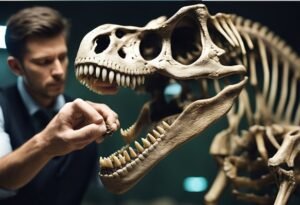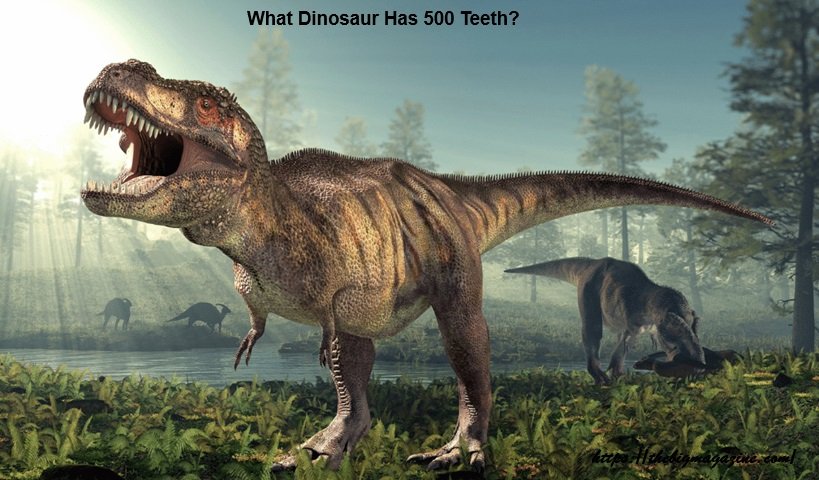What Dinosaur Has 500 Teeth? Dinosaurs have long captured the imaginations of scientists, students, and enthusiasts alike. These magnificent creatures, which once roamed the Earth millions of years ago, continue to fascinate us with their size, diversity, and sometimes bizarre anatomical features. Among the many dinosaurs that have been discovered, one particularly curious species has sparked widespread interest due to its unique dental structure: Nigersaurus, a dinosaur with 500 teeth. In this article, we’ll explore the fascinating details of the Nigersaurus, from its discovery to its unique characteristics and the significance of its 500 teeth.
The Discovery of Nigersaurus
Nigersaurus was first discovered in the 1970s by French paleontologists in the Republic of Niger, a country in West Africa. The dinosaur was named after the region where it was found, with “Nigersaurus” literally meaning “Niger lizard.” However, it wasn’t until the early 2000s that this dinosaur gained widespread attention, thanks to the work of American paleontologist Dr. Paul Sereno and his team. They uncovered more complete remains of Nigersaurus and were able to piece together a more detailed picture of this unique dinosaur.
What Did Nigersaurus Look Like?
Nigersaurus belonged to the group of dinosaurs known as sauropods, which are characterized by their long necks, large bodies, and typically herbivorous diets. Despite being a sauropod, Nigersaurus was quite different from the gigantic, towering dinosaurs like Brachiosaurus or Apatosaurus that we commonly associate with this group.
Nigersaurus was relatively small for a sauropod, measuring about 30 feet (9 meters) in length and weighing approximately 4 tons. Its body was relatively light and compact, with a short neck and a wide, flat snout. However, the most striking feature of Nigersaurus was its mouth, which housed a staggering 500 teeth.
The 500 Teeth of Nigersaurus: A Dental Marvel
Nigersaurus’s 500 teeth were arranged in a broad, straight row along the front of its mouth, rather than the U-shaped arrangement seen in many other dinosaurs. The teeth were highly specialized for its herbivorous diet, which primarily consisted of low-lying vegetation such as ferns, horsetails, and other soft plants.
The teeth of Nigersaurus were remarkably small and closely packed together, forming a dental battery that was ideal for efficiently processing large amounts of plant material. What made Nigersaurus’s dental structure even more unique was the presence of multiple rows of replacement teeth behind the functional ones. This meant that as the dinosaur wore down its teeth from constant grazing, new teeth would quickly take their place, ensuring that Nigersaurus always had a full set of functional teeth.
Nigersaurus’s teeth were also extremely thin and delicate, suggesting that it was not capable of chewing tough, fibrous plants like some other herbivorous dinosaurs. Instead, it likely used its teeth to strip leaves and other soft vegetation from plants before swallowing them whole.
How Did Nigersaurus Use Its Teeth?
The arrangement and structure of Nigersaurus’s teeth indicate that it was a specialized feeder, adapted to grazing on low-lying plants close to the ground. Unlike many other sauropods, which used their long necks to reach high into trees for food, Nigersaurus likely kept its head close to the ground, sweeping its mouth from side to side as it fed.
This feeding strategy is supported by the anatomy of Nigersaurus’s skull and neck. The dinosaur’s neck was relatively short and stiff, which would have limited its ability to lift its head high off the ground. Additionally, the wide, flat shape of its snout suggests that it was adapted for gathering food from a broad surface area, rather than selectively picking individual leaves or branches.
Nigersaurus’s highly specialized feeding mechanism likely allowed it to efficiently process large amounts of food, which would have been necessary to sustain its relatively large body size. Its unique dental battery, with its 500 teeth, would have been perfectly suited for this purpose.
The Significance of Nigersaurus’s Dental Structure
The discovery of Nigersaurus and its unique dental structure has provided valuable insights into the diversity of feeding strategies among herbivorous dinosaurs. While many sauropods were adapted for browsing on tall trees, Nigersaurus represents a different ecological niche, one that was specialized for grazing on low-lying vegetation.
Nigersaurus’s teeth also offer a fascinating example of evolutionary adaptation. The rapid replacement of its teeth ensured that it could continuously feed on abrasive plant material without wearing down its teeth to the point where it could no longer eat. This dental adaptation is similar to that seen in modern animals like sharks and some reptiles, which also continuously replace their teeth throughout their lives.
Why Is Nigersaurus Often Referred to as the Dinosaur with 500 Teeth?

The fact that Nigersaurus had 500 teeth has made it a subject of curiosity and intrigue among dinosaur enthusiasts and the general public alike. This unique characteristic has led to Nigersaurus being dubbed the “dinosaur with 500 teeth,” a title that has captured the imagination of many.
In recent years, the phrase “dinosaur with 500 teeth” has gained attention online, sometimes in the form of memes or as part of internet culture. However, beyond the viral aspect, this phrase highlights the remarkable nature of Nigersaurus’s dental structure and its significance in understanding the diversity of dinosaur species.
The Importance of Nigersaurus in Paleontology
Nigersaurus is an Important Discovery in the field of paleontology because it challenges the traditional views of sauropod dinosaurs and their feeding strategies. By studying Nigersaurus, scientists have been able to gain a better understanding of the variety of ecological roles that sauropods play in their environments.
The discovery of Nigersaurus has also shed light on the evolutionary pressures that shaped the development of specialized feeding mechanisms in herbivorous dinosaurs. It serves as a reminder that the world of dinosaurs was incredibly diverse, with different species adapting to a wide range of ecological niches.
Conclusion
Nigersaurus, the dinosaur with 500 teeth, stands out as one of the most unique and fascinating discoveries in the world of paleontology. Its specialized dental structure and feeding strategy offer valuable insights into the diversity of dinosaur species and their adaptations to different environments. As we continue to study and learn more about Nigersaurus, we gain a deeper appreciation for the complexity of life on Earth millions of years ago.
The legacy of Nigersaurus reminds us that there is still much to discover about the ancient world of dinosaurs. Each new find adds to our understanding of these incredible creatures and the ecosystems they inhabit. Nigersaurus, with its 500 teeth, is a testament to the wonders of evolution and the enduring fascination that dinosaurs hold for us all.
FAQs: What Dinosaur Has 500 Teeth?
1. Which dinosaur has 500 teeth?
Answer: The dinosaur with 500 teeth is Nigersaurus, a herbivorous sauropod that lived approximately 110 million years ago during the middle Cretaceous period.
2. Where was the Nigersaurus discovered?
Answer: Nigersaurus was discovered in the Republic of Niger, West Africa. It was first found in the 1970s, but more complete remains were uncovered and studied in the early 2000s.
3. Why did Nigersaurus have 500 teeth?
Answer: Nigersaurus had 500 teeth arranged in a broad, straight row. These teeth were specialized for grazing on low-lying vegetation. The dinosaur’s teeth were constantly being replaced, which was necessary for processing large amounts of plant material.
4. What did Nigersaurus eat?
Answer: Nigersaurus primarily fed on soft, low-lying plants such as ferns and horsetails. Its dental structure suggests that it grazed close to the ground, stripping leaves and other vegetation rather than chewing tough, fibrous plants.
5. How big was Nigersaurus?
Answer: Nigersaurus was about 30 feet (9 meters) long and weighed around 4 tons. It was relatively small for a sauropod but was still a significant herbivore in its ecosystem.
6. What makes Nigersaurus different from other sauropods?
Answer: Unlike other sauropods that typically had long necks for reaching high vegetation, Nigersaurus had a shorter neck and a broad, flat snout suited for grazing on plants close to the ground. Its unique dental structure, with 500 teeth, is also a distinctive feature.
7. How did Nigersaurus use its teeth?
Answer: Nigersaurus used its 500 teeth to graze on low-lying plants. The teeth were arranged in a way that allowed it to efficiently strip vegetation as it moved its head from side to side while feeding.
8. Did Nigersaurus replace its teeth?
Answer: Yes, Nigersaurus had a rapid tooth replacement system. Behind each functional tooth, there were multiple replacement teeth ready to take over as the front teeth wore down from constant use.
9. What era did Nigersaurus live in?
Answer: Nigersaurus lived during the middle Cretaceous period, approximately 110 million years ago.
10. Why is Nigersaurus sometimes called the ‘dinosaur with 500 teeth’?
Answer: Nigersaurus is often referred to as the “dinosaur with 500 teeth” due to its unique dental structure, which has captured the interest and curiosity of many dinosaur enthusiasts and the general public.
